The 2020/21 season will mark just the third season since Wolves were promoted to the Premier League after winning the Championship, even though it might feel like they have been around for longer. A possible reason for that is the fact that they have rarely been troubled with relegation struggles, finishing in seventh place in both their seasons in the top flight so far under Nuno Espirito Santo. That is a fantastic achievement for a promoted side, although Wolves are far from the typical team in that respect. Owned by Chinese conglomerate Fosun International, and with close ties to Portuguese super-agent Jorge Mendes, Wolves have managed to recruit at a high level over the last couple of seasons, and even back when they were in the Championship, having signed one of the most highly-rated young midfielders in Europe, Rúben Neves, from Porto back then. There has been a distinct Portuguese flavour to their recruitment, with nine first-team players part of the squad at present, and the links with Mendes have helped them bring in some top-quality players, to allow them to be able to challenge for European places right from the get-go.
This summer marks the first time that Wolves have lost key first-team players, though. Matt Doherty was snapped up by Tottenham for just £15 million, while Diogo Jota has moved on to Liverpool for a fee that could potentially be as high as £45 million. The West Midlands outfit have not been idle, bringing in Fernando Marçal from Olympique Lyon for just under £2 million, while splashing out £35 million (a club-record fee) on 18-year-old striker Fábio Silva. There are rumours at the time of writing linking them to Barcelona right-back Nélson Semedo as well, which would give Nuno a replacement for Doherty at right wing-back, while also boosting the Portuguese contingent at the club. However, a case can be made for further recruitment, especially in central midfield. Nuno likes working with a small, tightly-knit squad, but the demands of European football over the last season, combined with the short turnaround between seasons this time around, could put an even greater strain on the squad. Wolves do not have European football this season, but we believe that they could still do with a central midfielder, as Neves, João Moutinho, and Leander Dendoncker are the only midfield options at Nuno’s disposal. Romain Saïss is more often deployed as a centre-back nowadays, while Morgan Gibbs-White and Bruno Jordão are out on loan. Thus, in keeping with Wolves’ tendency to go for Portuguese players (and Jorge Mendes clients), we believe that Lille midfielder Renato Sanches would be an excellent option for them, as he would offer something different to all the midfielders already at the club and get the chance to get his career back on track after a hugely promising start.
Most fans would remember Sanches as being part of the victorious Portugal squad at EURO 2016, winning the coveted Golden Boy award for U-21 European footballers that year as well. However, a big-money move to Bayern Munich failed to work out, with a bizarre loan spell at Swansea City thrown in as well, and Sanches became Lille’s record signing last year. This tactical analysis will attempt to explain why he would be a good fit for Wolves, and what his strengths and weaknesses are.
Comparison with Wolves’ midfielders
One interesting aspect of how he has been used by Cristophe Galtier at Lille is that he has often been fielded out on the right flank, rather than as a central midfielder, in the French manager’s preferred 4-4-2 system. He has, of course, played a lot in his usual central midfield slot as well, but this shows his versatility as well as the unique skill-set which makes it possible for him to be fielded in wider areas. A look at his heatmap from last season shows the areas in which he was most influential –
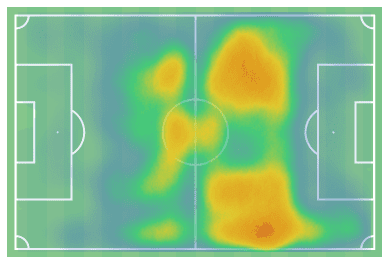
We can see how he was most often found in the wider areas on both sides of the pitch, rather than in deeper central positions. This would work well with Wolves’ system, as Nuno almost exclusively uses a back-three, either in a 3-5-2 or 3-4-3 configuration, and so Sanches could be fielded as one of the central midfielders, but tasked with getting upfield and into wider areas to provide support to the wing-back.
It’s also beneficial to look at the heatmaps of the other three Wolves central midfielders from last season, to see how Sanches could fit in. Here is Moutinho’s map –
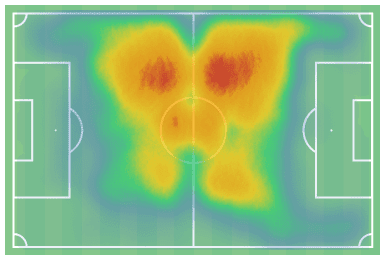
You can see how he generally plays on the left side, covering the wider areas in addition to his central responsibilities. It is a similar case for Neves as well –
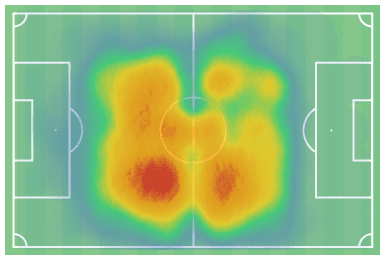
Once again, we see that the midfielder moves out to wide areas reasonably often, although not as much as Moutinho, and most of his work is done centrally. Finally, we take a look at Dendoncker’s heat map –
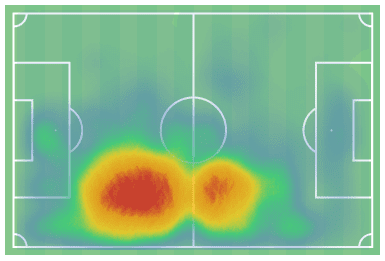
This map is due to the fact that the Belgian was often fielded as one of the centre-backs, rather than in midfield, throughout last season and that pattern is set to continue this time around as well.
Thus, these heatmaps show how Sanches could potentially be a good midfield option for Wolves, as he is already used to occupying a lot of the spaces that would be a part of his role in Nuno’s system.
We will now look at Sanches’ statistics, in comparison with the current Wolves midfielders, to show where the Portuguese midfielder can add to Nuno’s squad. We will be using radar charts for this, to clearly display areas where one player was better than the other last season. All numbers are taken for the 2019/20 season, and are per 90 minutes.
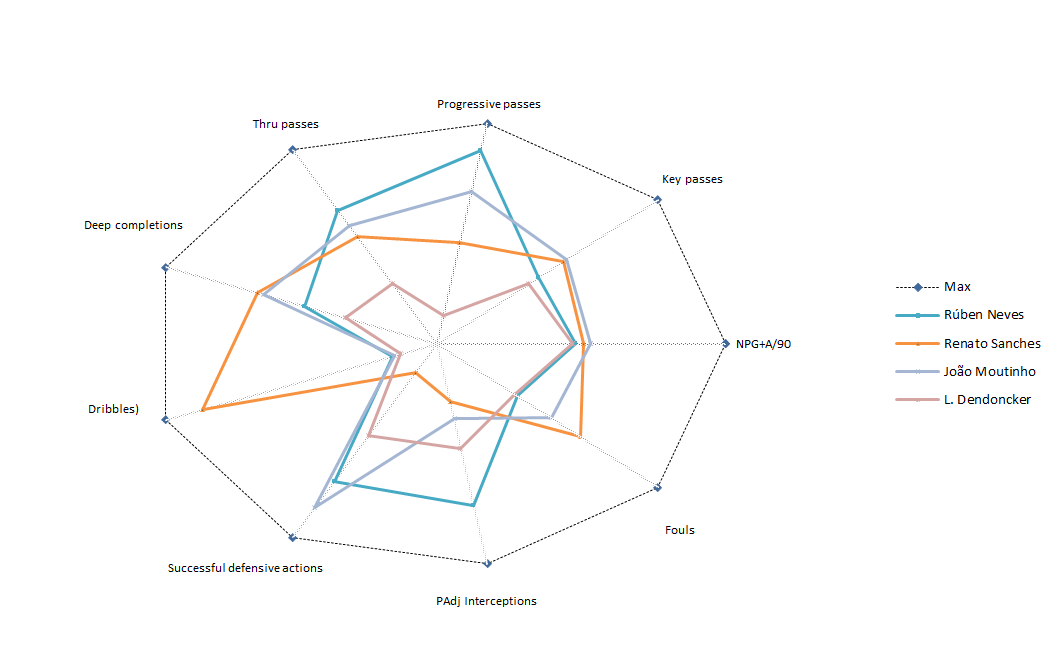
This radar chart shows some key indicators for all four players and allows us to compare their strengths and weaknesses. We can see that Neves, for example, was the player with the most progressive passes/90 of these four players, while Moutinho had the most successful defensive actions. Sanches’ clear strength lies in dribbling – he outperformers the other three midfielders by a huge margin here, and the actual numbers will make this clear as well. Sanches attempted 6.01 dribbles/90 last season, while these were the corresponding numbers for the Wolves midfielders – 0.89 for Neves, 0.83 for Moutinho, and 0.68 for Dendoncker. Thus, it can be clearly seen that he would add something different to the Wolves midfield, with the ability to carry the ball upfield at pace and beat opposition players while doing so. It is also worth noting that Sanches performed well on a number of the other metrics – he had 0.2 non-penalty goals + assists last season per 90 minutes, only lower than Moutinho’s 0.25 in our comparison, and it was a similar case for key passes as well – Sanches made 0.41 key passes/90 last season, more than Neves’ 0.14 and only marginally lower than Moutinho’s 0.44. He led our comparison for deep completions as well, with 1.27 per 90, compared to 1.2 for Moutinho, 0.3 for Dendoncker, and 0.75 for Neves, and while he may have been the lowest for defensive actions, a total of 7.07 successful defensive actions/90 is not a shabby number for a midfielder, especially one who was frequently played on the flank.
This statistical comparison shows us that Sanches can add a very different dimension to the Wolves midfield, as he will bring the ability to dribble and progress the ball upfield that none of the other Wolves midfielders possess. We will now look at some in-game examples of his skills.
Playing profile
Shooting and goalscoring
Perhaps because he was often used out wide, and therefore had more opportunities to get into the box, Sanches scored four goals last season. This may not seem like a large number, but the variety and efficiency of his finishing is a good indicator that he can be relied on in front of goal if he gets a chance, especially from outside the box. Wolves already have Neves who is adept at scoring from distance, and in Sanches, they could potentially get another player who would be a real threat from any distance within 25 yards or so of the goal.
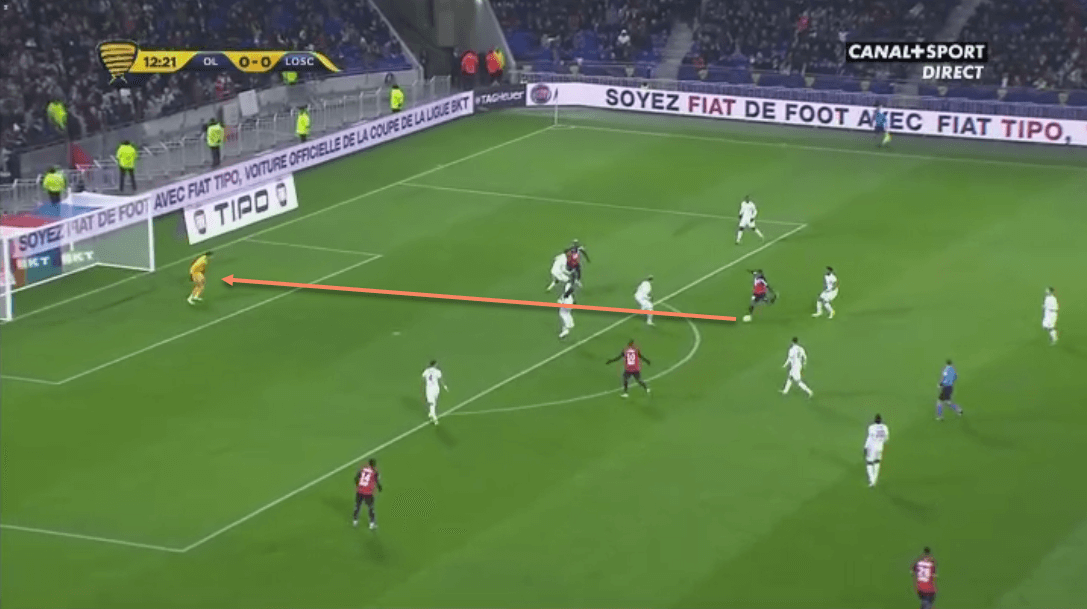
Here, Sanches sneaks the ball into the near post area from outside the area with his weaker left foot, despite the angle suggesting that he should go for the far post.
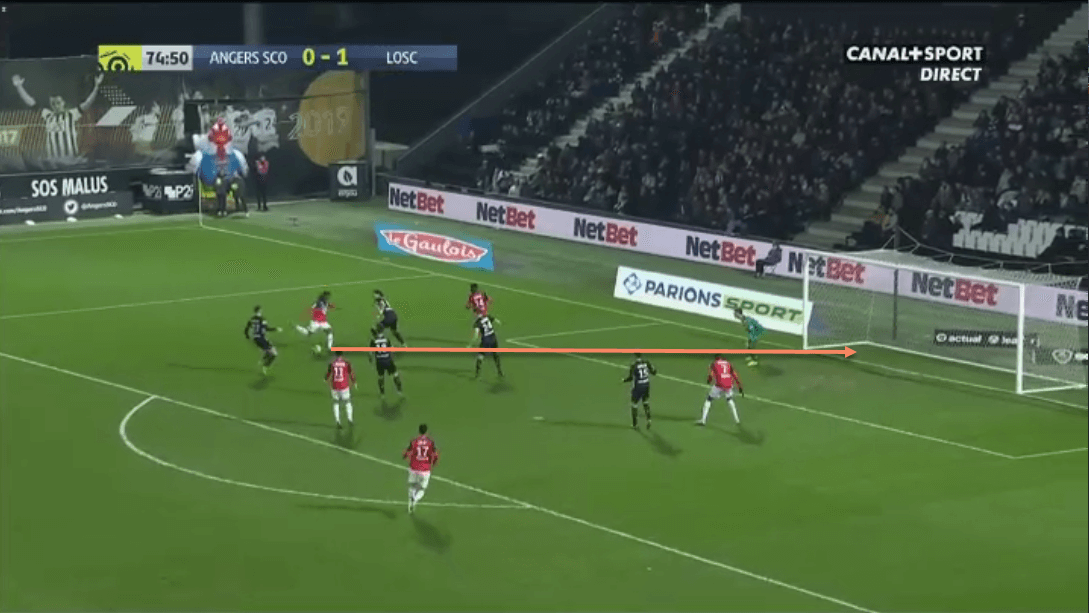
A similar case here, where Sanches comes inside and wrong-foots the goalkeeper by going for the near-side with power.
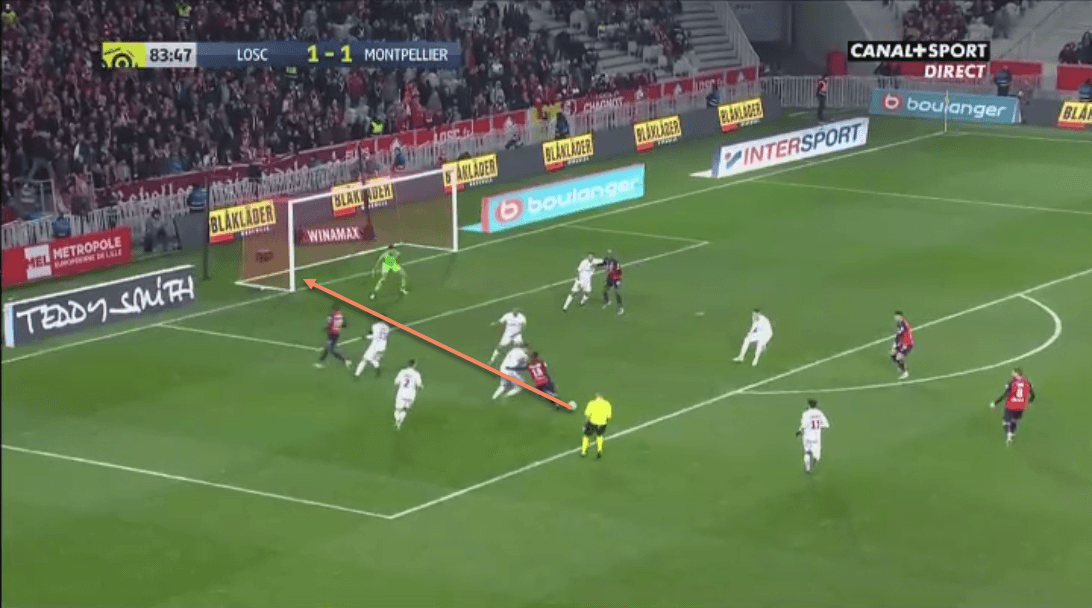
Finally, here too, the Portuguese international drifts infield from the left and chooses to hit the near-post area with power. If you look closely at the image, you will see that the keeper is leaning slightly to his left and his body weight is planted on his right foot – a sure sign that he expects the shot to go to the far post and thus he needs to dive to his left, but Sanches’ shot catches him out.
This is admittedly a very small sample size, but Sanches’ tendency to wrong-foot goalkeepers with his shooting last season is something which can be worked on and improved on the training ground, to give his team a potent attacking weapon whenever he manages to get on the ball in and around the penalty area.
Passing
As impressive as this nascent ability may be, goalscoring will not be Sanches’ primary role in the Wolves’ midfield. He will need to spread the play wide to the wing-backs, as well as link up with the strikers when they drop deep. Sanches’ ability on the ball in terms of his passing is top-class, as can be seen in the examples below –
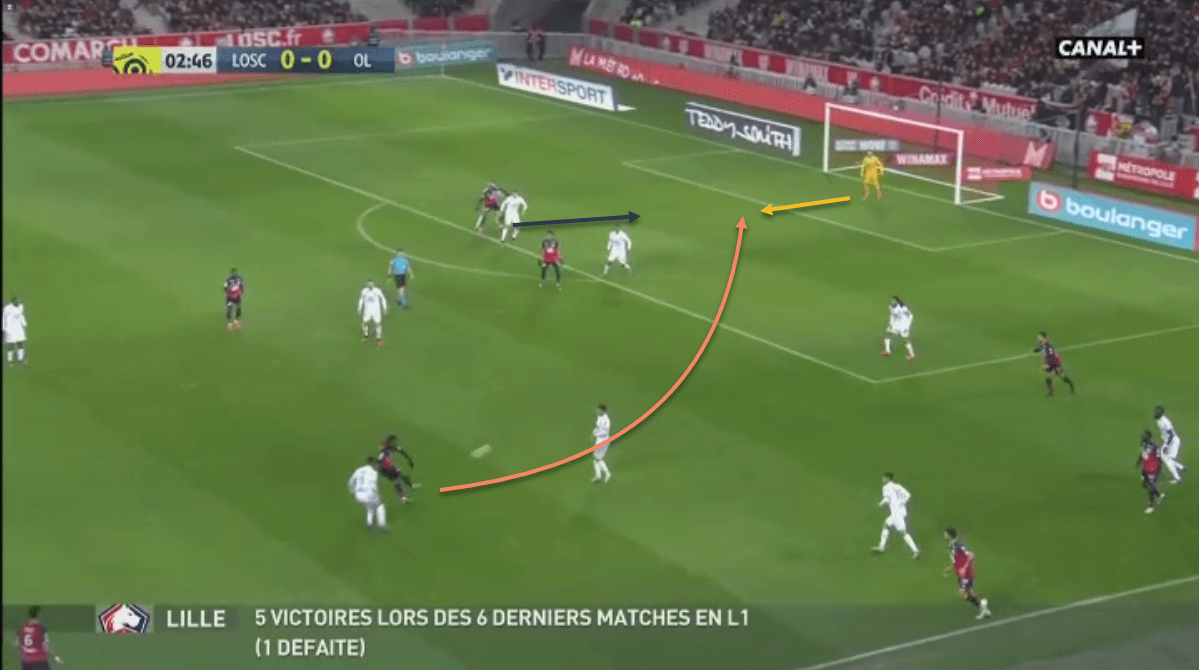
In the above image, Sanches’ first-time pass into the box is intercepted by the Lyon goalkeeper before his teammate can get to it, but what is impressive is his vision to see the pass and even attempt it, especially with his first touch.
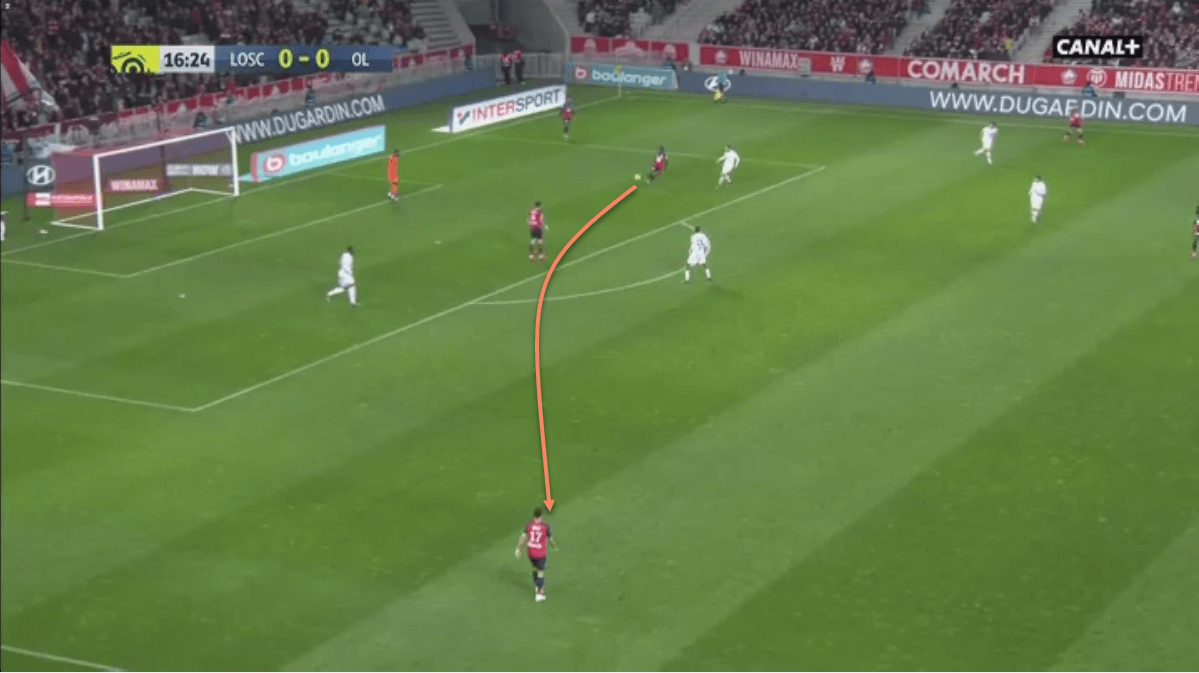
He is also comfortable dropping deep, even into his own box, to play the ball out wide to his full-back, as can be seen above.
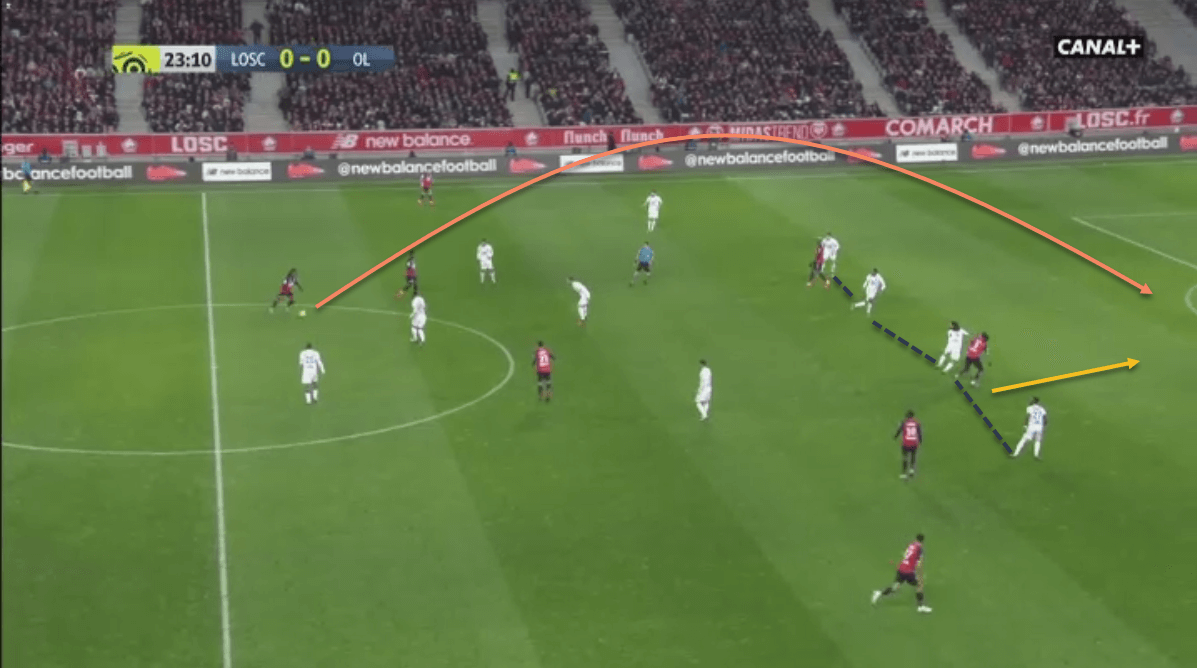
Here, Sanches is able to pick out the striker with an inch-perfect ball over the top of the Lyon defence, and only a poor touch from the striker ruins what could have been a clear chance on goal.
While these are just a few examples, all taken from one match, they still go to show how Sanches’ has an exemplary passing range, with the vision to spot teammates in space and players making runs, and the ability to find them as well. This is not too dissimilar to the role that Moutinho, and especially Neves, plays for Wolves, spreading the ball to the flanks as well as playing passes over the top or into the channels for the strikers to run onto.
Dribbling
As we have established in the player comparison earlier, Sanches’ biggest point-of-difference in the Wolves midfielder would be his dribbling ability. The Portuguese international is extremely adept with the ball at his feet, capable of gliding past opponents into space with a dip of his shoulder or through a feint.

Here, Sanches is 1 v 1 with the Lyon defender, who is expecting him to go to his left (yellow arrow). He is promptly able to feint past him and move into space down the right flank (orange arrow).
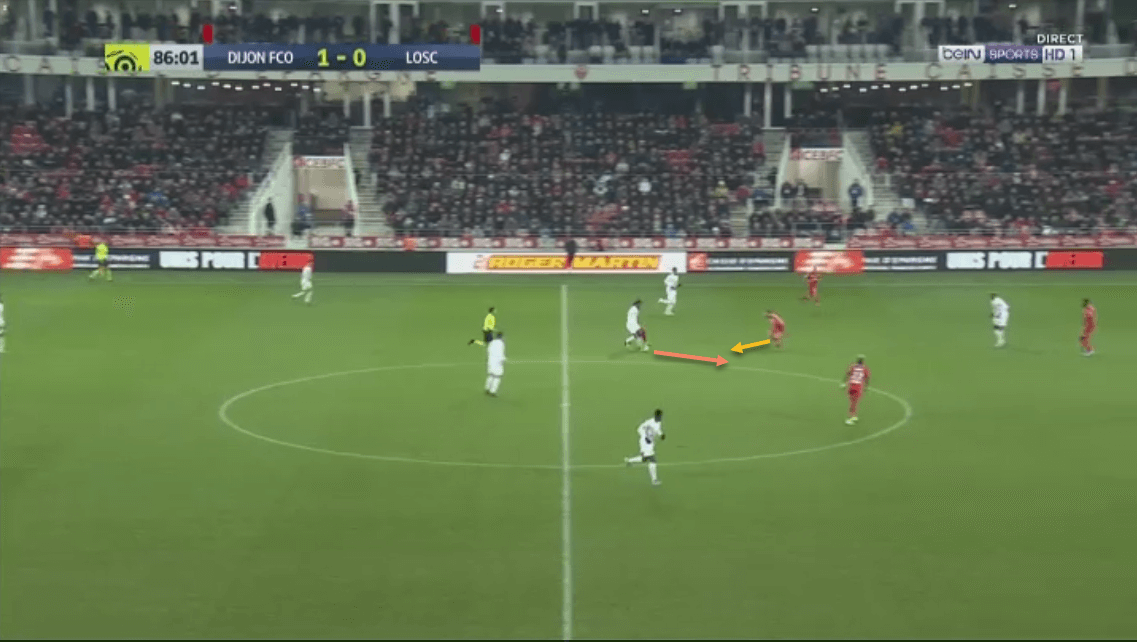
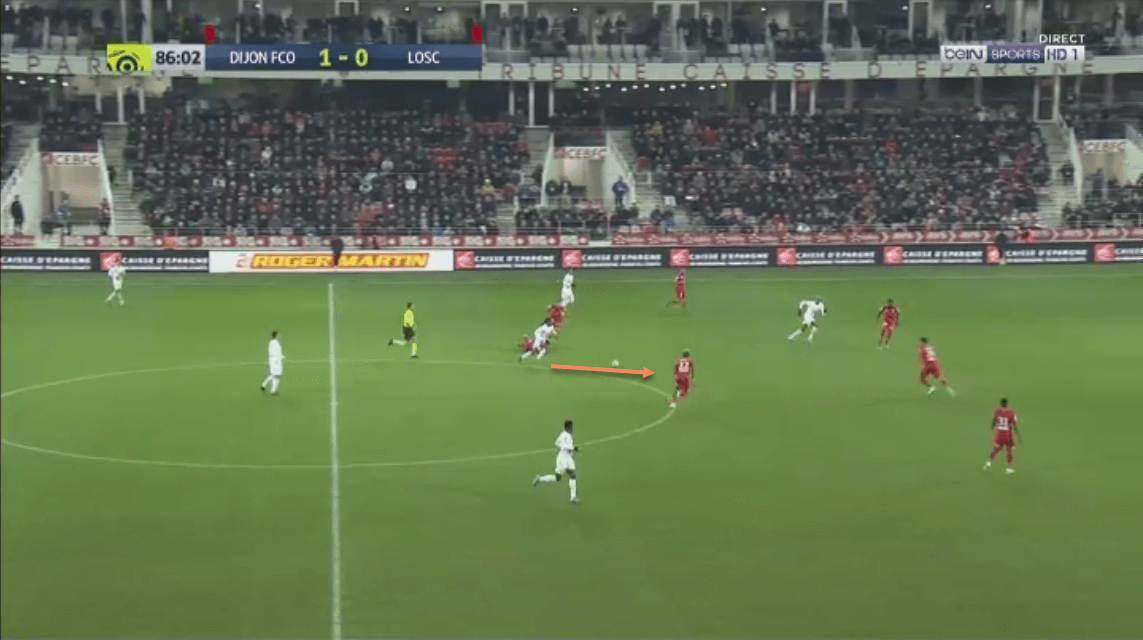
This two-image sequence sees Sanches running with the ball through the centre of the pitch, with one Dijon midfielder in close attendance, and another moving towards him. We see that he has managed to leave both players behind with a swift shuffle of the ball, and is now able to run onto it at pace, drawing more players towards him and thus creating space for teammates if he can find them with a pass.
This ability to wiggle out of tight spaces and dribble past opponents is crucial to progressing the ball upfield, and it is an extremely rare quality for a central midfielder. There are very few central midfielders at the top level who are adept at dribbling, and having this skill in his locker will allow Sanches to be a dangerous option for his team, whichever team it may be.
Conclusion
Renato Sanches is one of the latest in a long line of young players who have seen their careers written off after a poor couple of seasons, which failed to live up to the standards set by their explosive beginnings. The Portuguese midfielder was perhaps never as great as he was made out to be when he first burst onto the scene, but at the same time, he remains a very good player, with a unique skill-set which can be of great use to many teams. He has the passing range and athletic ability to be able to play in central midfield for top sides, and coupled with his dribbling, it makes him a very dangerous opponent to face. Sanches has Premier League experience as well, however badly his spell at Swansea may have been, but a move to Wolves would suit both him and the club. Wolves would get a young, energetic midfielder who offers something different to their existing players, while Sanches would have the benefit of having a number of compatriots in the dressing room to help him settle into life in the West Midlands, while also coming under the tutelage of one of the best recent developers of talented players in Nuno. We believe that given the Portuguese connections that are already present at Molineux, Wolves should definitely consider bringing Sanches in to continue their Portuguese revolution in the Premier League.

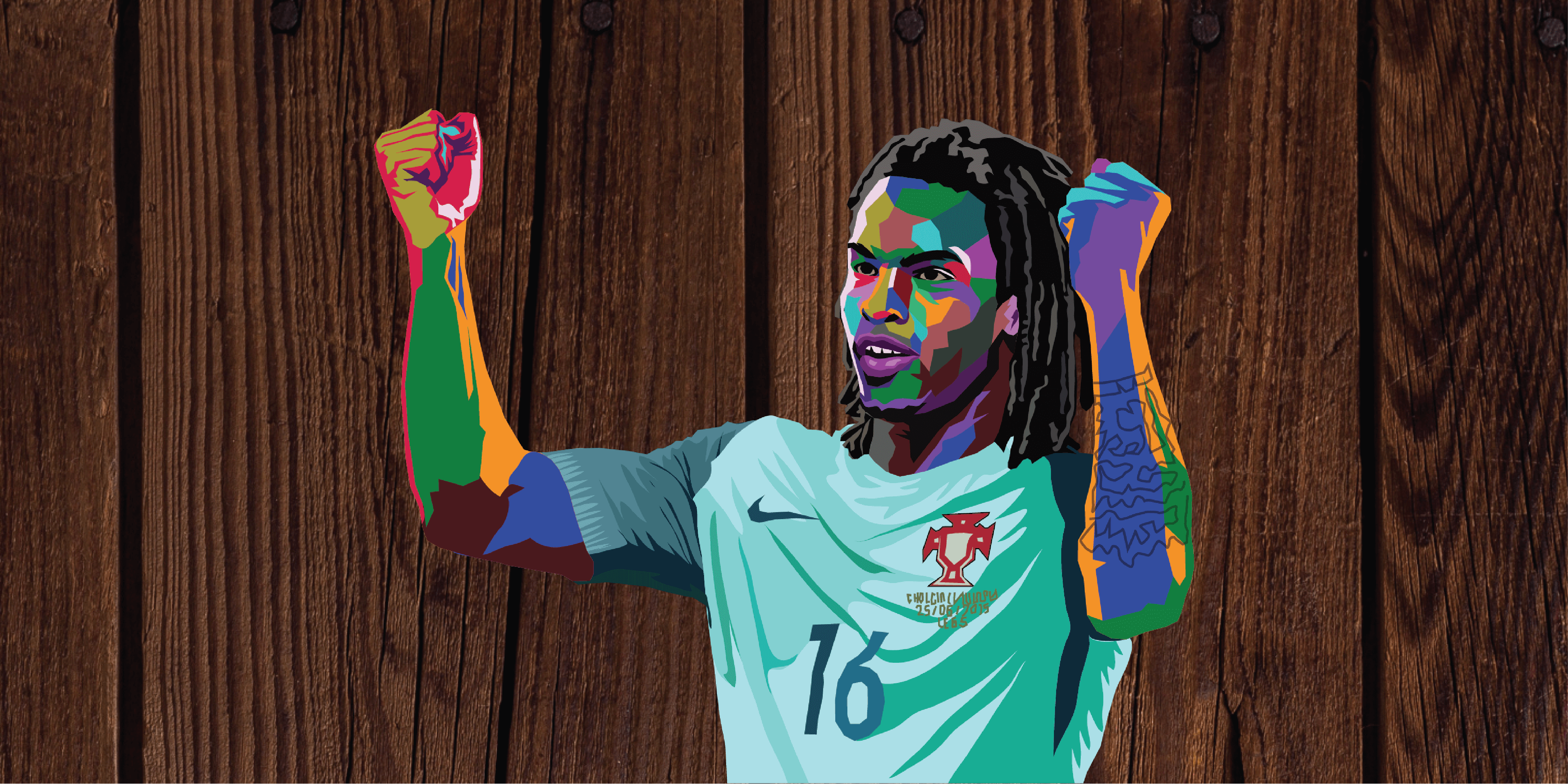



Comments